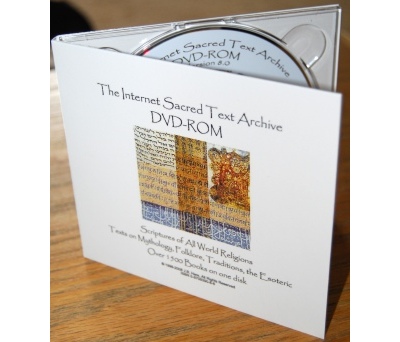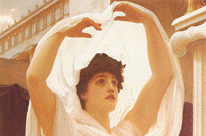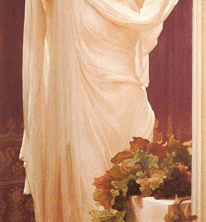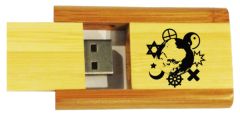Sacred-texts home
Internet Book of Shadows
Grimoires
Esoteric and Occult
Legends and Sagas
Shamanism
Classical Paganism
Women
Tarot
Sacred Sexuality
OCRT: Neo-Pagan Religious Traditions
OCRT: Asatru (Norse Paganism)
Buy CD-ROM
Buy Books on Neopaganism and Wicca
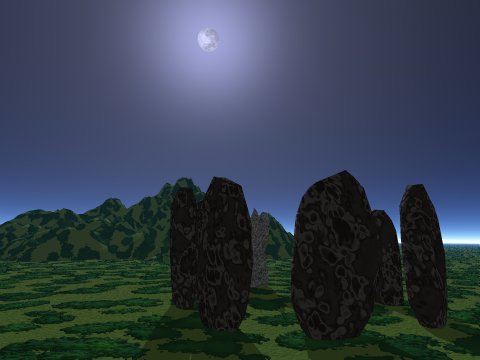
Image © Copyright J.B. Hare 1999, All Rights Reserved |
Wicca and Neo-Paganism
|
Twentieth Century
Victorian
The Burning Times
Druids
Antiquity
Miscellaneous
 Current Phase of the Moon
Current Phase of the Moon
Neopaganism covers a wide range of belief systems
which have emerged in the past 50 years,
primarily in the UK, Europe, and the United States.
This includes the better known Wicca, which is a synthesis of
traditions from the British Isles, as well as many less visible
groups which draw inspiration from other parts of the world.
Based on folk-lore, traditional spiritual practices,
anthropology, and a synthesis of esoteric systems, Neopaganism does
not have any sacred texts of the same vintage as other religions,
although unverifiable claims have been made in a couple of cases
(e.g. Aradia,
and The Gardnerian Book of Shadows).
Rather, the books presented here are source texts of Neopaganism, and
other books which deal with related topics.
Many of these books contain outdated or speculative material,
and some of the texts here are the product of the Renaissance witch hunters.
As a whole, the books here are of historical importance rather
than a roadmap to modern pagan practice, and shouldn't be construed as such.
As always, we encourage readers to think critically.
Descriptions of contemporary Neopagan practice and beliefs can be found
in the Internet Book of Shadows section
of this site.
The Books of Gerald Gardner
 The Gardnerian Book of Shadows
The Gardnerian Book of Shadows
The Book of Shadows is a Wiccan text which is maintained by
the initiated in manuscript form.
A Book of Shadows contains description of rituals, spells, and other
knowledge.
This tradition was carried on by Gerald Gardner, who (depending on the
account) either synthesized Wicca, or took it public, during the 1950s.
The White Goddess
Robert Graves' primary contribution to modern Neopaganism.
 The works of Margaret Murray
The works of Margaret Murray
An essay by J.B. Hare.
 The Witch-Cult in Western Europe
The Witch-Cult in Western Europe
by Margaret Murray [1921]
Were there ever REAL witches?
If not, what were all the witch trials about?
And how about those fairies?
Murray tries to answer these and other questions objectively with
plenty of documentary evidence.
She is often cited as a primary source for Gerald Gardners' ideology.
 The Golden Bough
The Golden Bough
by Sir James Frazer [1922]
A massive study of the mythological cycle of
the Godesses' lover, the solar God who dies and
is reborn. The Golden Bough had a huge influence on
Margaret Murray,
Robert Graves and Gardner.
 Aradia, Gospel of the Witches
Aradia, Gospel of the Witches
by Charles G. Leland [1899]
Evidence of a surviving underground Italian pagan religion?
 Etruscan Roman Remains in Popular Tradition
Etruscan Roman Remains in Popular Tradition
by Charles G. Leland [1893]
Stregheria is Italian traditional witchcraft.
These are considered historical source documents
of the Wicca movement. Some contemporary scholars
have questioned the authenticity of Lelands' scholarship.
Recent publications by Raven Grimassi have also
added a great deal of depth to the subject of Italian witchcraft.
See www.stregheria.com [external site]
for more information.
 Gypsy Sorcery and Fortune Telling
Gypsy Sorcery and Fortune Telling
by Charles G. Leland [1891]
Leland investigates another traditional system of magic, that of the Rom, or Gypsies.
 Letters on Demonology and Witchcraft
Letters on Demonology and Witchcraft
by Sir Walter Scott [1885].
Scott covers much of the same evidence for the Witch cult as Murry
(albeit in a more popular style).
Scott draws few conclusions other than
that our ancestors were extremely superstitous.
 The Sorceress
The Sorceress
by Jules Michelet, tr. by Alfred Richard Allinson [1939]
The story of witchcraft from the medieval to the 17th century, as a covert women's rebellion which led to modern science and medicine.
From the 14th to the 17th Century a hysteria spread across Europe
which involved torturing and executing people based on accusations
that they were witches.
Whether any actual practicioners of a pre-Christian pagan tradition were
persecuted as the result of a witch trial is up for debate.
These books and texts are period documents which illustrate
the methods, rationale (such as it was) and history of this persecution.
They shouldn't be taken as illustrative of Neopaganism, but as
a warning about religious tolerance and the fragile nature of justice.
 The Malleus Maleficarum
The Malleus Maleficarum
[1486], translated by Montague Summers [1928]
The best known witch-hunt manual, a primary source of information on this chilling subject.
 Dæmonology
Dæmonology
by King James the First. [1597]
With Newes from Scotland [1591]
Two texts, one an essay on demons and other denizens of the night, the
second a broadside with an account of a famous witch trial from the same
period.
 The Witch-Persecutions
The Witch-Persecutions
Edited by George L. Burr [1896].
A short collection of translations of historical documents of the witch craze.
Although little is actually known about the Druids, that didn't
stop 18th and 19th century intellectuals from building a romantic
mythology around them.
This was closely associated with the rebirth of
Celtic nationalism,
as well as the Romantic and
Gothic movements.
This body of fact and speculation later became a central source
of modern Wicca and Neo-Pagan belief and practice.
 Irish Druids and Old Irish Religions
Irish Druids and Old Irish Religions
by James Bonwick [1894].
A scholarly perspective on the Druids in Ireland, weaving together strands of mythology and anthropology to build a picture of ancient Irish paganism.
 The Veil of Isis or Mysteries of the Druids
The Veil of Isis or Mysteries of the Druids
By W. Winwood Reade [1861].
277,613 bytes
A typical example of the romantic and misconcieved mid-19th Century literature about Druidry.
We now know that the construction of Stonehenge
preceded the historical Celts by many centuries.
 The Religion of the Ancient Celts
The Religion of the Ancient Celts
by J. A. MacCulloch [1911]
An authoritative and factual study of ancient Celtic religion,
including extensive material on what is actually known about the Druids.
 The Barddas of Iolo Morganwg, Vol. I [1862]
The Barddas of Iolo Morganwg, Vol. I [1862]
 The Barddas of Iolo Morganwg, Vol. II [1874]
The Barddas of Iolo Morganwg, Vol. II [1874]
Iolo Morganwg was one of the first to revive Druidry in
the 18th century; however, it is questionable whether these texts
are as old as they claim to be.
These are nevertheless considered primary source material
for the modern Druid revivial.
 The Syrian Goddess
The Syrian Goddess
translated by Herbert A. Strong [1913]
Lucian of Samosata's late classical account of Goddess worship,
referenced by Robert Graves and other writers as a primary source of
information on worship of the Ancient Near Eastern Goddess.
 The Book of Hallowe'en
The Book of Hallowe'en
by Ruth Edna Kelley [1919]
Learn about Halloween and its pagan roots.
 Irish Witchcraft and Demonology
Irish Witchcraft and Demonology
by St. John D. Seymour [1913].
This is a fascinating study of the witch-persecutions in Ireland, along with accounts of paranormal activity.
 Pagan Prayers
Pagan Prayers
by Marah Ellis Ryan [1913]
Traditional spirituality from around the world.

